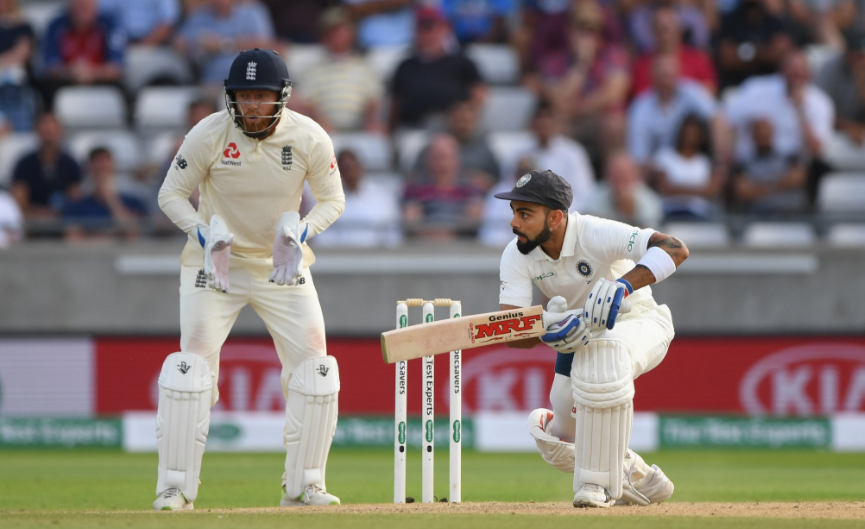England Win. India Lose. Test Cricket Gasps for Air

The Edgbaston Test provided no real contest between the bat and the ball, except when Virat Kohli, Sam Curran and Joe Root stood up to the fired up bowlers running in under friendly conditions (Pic: Twitter, ICC).
The Edgbaston Test has left a sour taste in the mouth. It is not because India lost. The series opener in Birmingham reiterated something more alarming than Virat Kohli and Co’s fall in a country where the Indian cricket team has had very little success over the years. Test cricket, the version we used to know, love, rave and romanticize about, is not around anymore. What we have got, what we saw at Edgbaston, is a genetically modified clone.
The sporting arena, as a microcosm, reflects the world it is part of; the world which, of late, discards anything and everything non-entertaining. Amusing, or entertaining the modern homosapien, with the very limiting constraint of time -- the short attention span of our techno-evolved brains -- is quite a challenge. The five-day Test cricket, its solid foundation in history notwithstanding, has been shaken to the core living that challenge.
And matches such as the England vs India Test at Edgbaston, which ended on the fourth day (August 4) with a 31-run victory for the hosts, are prime examples of the easy-to-understand but difficult-to-digest change.
Also Read | Heat on Virat Kohli as Essex Match Exposes Unsettled India
Having said that, the match was entertaining, churning out a “nail-biting” result, a prerequisite for sports entertainment -- the winners-take-all philosophy we adhere to at the moment doesn’t accommodate draws, while the influx of T20 cricket has primed fans of the game for quick and assured victories and losses.
Test cricket is barely keeping its nose above water, and is gasping for air, for spectators even. The Indian cricket team, with Virat Kohli holding fort against an onslaught of England pacers in swinging conditions, trying for a victory on what was essentially the final day of the Edgbaston Test, should have attracted thousands. But it wasn’t so. The opening session, which turned out to be the last of the match, played to quite a lot of empty seats. This, on a Saturday, in the country where cricket was born, and where quite a lot of NRIs (Non-Resident Indians) live.
Empty stands is just one of the many fronts Test cricket is fighting at the moment. And all those battles, from existential questions such as relevance, to challenges thrown in by the direction the game is heading in, has changed the purest form of cricket.
Also Read | Gautam Gambhir, Virender Sehwag in DDCA’s New Conflict of Interest Controversy
The evolution we are talking about was never organic. It was brought about when cricket hit upon a goldmine called Twenty20 a decade back. But what the changemakers didn’t foresee was how T20, and the new economy and boom it has brought into cricket, would change the cricketers, thereby changing, or scarring the purest form of the game forever.
In the quickie world of T20, cricketers have found a forgiving, and forgetting haven, in addition to the the big bucks it provides them. The short format of cricket demands less from the cricketers, emotionally, physically and technically too.
Test cricket, however, is the exact opposite. It demands much more than flashy strokes from the batsmen; squeezes out not just spin, swing or bounce, but real emotions from the bowlers. The ensuing contest was in true essence a life-and-death tussle, between the bowler and the batsman, between two teams and their idea of cricket, and much more romantic than all that, a true contest between the bat and the ball. It was a test of character and human spirit as much as it was a test match of cricket.
Also Read | No Contracts, Absurd Sackings: Former Coach Reveals Unprofessional Side of Indian Women’s Cricket Team
The Edgbaston Test provided nothing of that, except when Kohli, Sam Curran and Joe Root stood up to the fired up bowlers running in under friendly conditions.
In fact, many Tests in the recent past have fallen short of the hallowed benchmark of matches of yore. Kohli’s, Curran’s or Root’s innings in the Test was proof that the Edgbaston pitch was playable. Application and confidence was all that was needed.
The trio showed what Test batsmanship is all about. Technique, gumption and desire. The rest, perhaps, had the heart and will for a fight, but lacked the means. After all, they are spoilt by the flat decks rolled out day in and day out through the season, catering to the six and four-hungry fans, who look at cricket more as popcorn entertainment and less as an emotional investment which was the essence of sports spectatorship not so long back.
It was evident in Edgbaston that the best modern day batsmen, barring a very special few -- the Kohlis of the world -- are technically challenged to face real questions from a bowler. Real questions that the bowlers used to ask standing on the exalted platform Tests used to provide them.
Also Read | How the Cricketing World Failed Afghanistan
These days if a Test venue provides such a platform, a whiff of a bowler-friendly pitch, the match ends in three days. A result is guaranteed but like in Edgbaston, the famed batsmen in both the teams fail to offer up a resistance.
Their individual failure is a collective failure of the system which has allowed professional cricketers to survive, quite splendidly that too, despite being less than perfect in technique. Imagine a situation where a school or university subtly phases out talented and knowledgeable teachers for more entertaining ones, bowing down to student preference. Cricket, in a deeper sense, is doing the same with its players.
It is not heritage nor history that makes a sport what it is at a given point in time. It is the players. And despite the big bucks coming in from the sponsor and gate-revenue rich competitions, cricket seems to have gotten poorer.
Get the latest reports & analysis with people's perspective on Protests, movements & deep analytical videos, discussions of the current affairs in your Telegram app. Subscribe to NewsClick's Telegram channel & get Real-Time updates on stories, as they get published on our website.
























